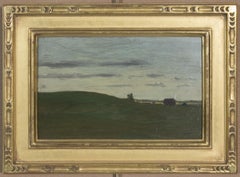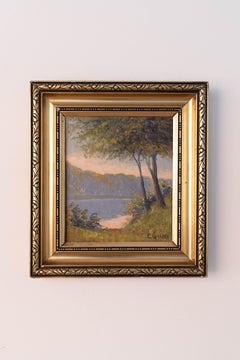Soren Emil Carlsen Art
American, 1853-1932
Born Soren Emil Carlsen in Copenhagen around 1853, Carlsen first began his studies at the Royal Danish Academy as a teenager. Yet he was not to remain long there, leaving in 1872, at nineteen years old for America where he settled in Chicago, working for an illustration house to support himself.
By 1875 he had saved enough money to travel to both Paris and Copenhagen to paint and study, staying for six months before returning to America, this time to New York. By this time he had already developed a unique love affair with the still life. In New York he befriended fellow painters such as John Francis Murphy; yet the city could not contain him and after only a year he relocated to Boston, making friends with the likes of Childe Hassam with whom he maintained a life-long friendship.
Carlsen remained quite poor throughout his time in Boston where he spent the next eight years. Yet his abilities were developing quite rapidly in still life painting, in a style which scholars refer to as “kitchen still lifes.” that often included fish or birds paired with pots and pans suggesting the presence of a cook outside the frame and introducing a human element to still life subjects. This style very much echoed the work of the Dutch and Spanish Masters of still life, particularly that of Jean Simeon Chardin and, to a lesser degree, Johannes Vermeer. The similarity is not coincidental, as Carlsen spoke and wrote often of the influence of these artists on his own work, and yet he was already beginning to develop the eye for color, light and composition that today we regard as the undeniable Carlsen style.
In 1884 Carlsen moved again to Paris, staying for two years. Here, as always he kept a low profile, preferring the mediation of working in the studio to the more social and recreational gathering places of artists and expatriates. In 1887 Carlsen moved to San Francisco, working for the directorship of the San Francisco Art Association School, and in 1891 moved back to New York where he lived until 1901. It is during this period, in the last decade of the nineteenth century that could be regarded as the most formative in terms of the development of the techniques that produced the paintings for which he is most celebrated today.to
1
1
Overall Width
to
Overall Height
to
1
1
1
1
1
8,780
2,809
1,654
1,312
1
1
Artist: Soren Emil Carlsen
Emil Carlsen American Impressionist landscape oil Painting Salmagundi Club
By Soren Emil Carlsen
Located in Chesterfield, NJ
Yellow Landscape/Wood Interior/Birch Forest
3 different titles on 3 labels
DESCRIPTION
Yellow Landscape oil /panel
bears Florence G. Carlsen Estate stamp on Brett Mitchell Collecti...
Category
Early 20th Century Tonalist Soren Emil Carlsen Art
Materials
Oil
Related Items
French school The River Oil painting Signed
Located in Zofingen, AG
➡️The River from Rousseau⬅️
"Il est tombé par terre, C'est la faute à Voltaire, Le nez dans le ruisseau, C'est la faute à Rousseau" - He fell to the ground, It's Voltaire's fault, H...
Category
1890s Tonalist Soren Emil Carlsen Art
Materials
Gesso, Canvas, Oil, Stretcher Bars
$595 Sale Price
79% Off
H 12.41 in W 18.71 in D 1.19 in
Green Field and Barn - A Tonalist Landscape by Robertson Mygatt
Located in Philadelphia, PA
Robertson K. Mygatt
(American, 1862-1919)
Green Field and Barn
Oil on panel, 6 1/8 x 9 7/8 inches
Framed: 10 x 15 inches
The landscape painter and etcher Robertson K. Mygatt was born in New York City and studied at the Art Students’ League with John Twachtman...
Category
1910s Tonalist Soren Emil Carlsen Art
Materials
Oil, Wood Panel
$4,000
H 6.125 in W 9.875 in
Tonalist Painting Sunset Figures Wheat Barbizon Framed 19th Century Oil Painting
Located in Buffalo, NY
An antique oil painting in its original ornate gold leaf frame.
This tonalist painting depicts figures against a dramatic sunset.
The work is signed illegibly lower left. It ap...
Category
1860s Tonalist Soren Emil Carlsen Art
Materials
Canvas, Oil
$2,280 Sale Price
20% Off
H 23.5 in W 29.5 in
Dennis Sheehan, "Across the Marsh", 18x24 Tonalist Landscape Oil Painting
By Dennis Sheehan
Located in Saratoga Springs, NY
This piece, "Across the Marsh", by artist Dennis Sheehan is a 18x24 oil painting on canvas featuring a marshy green landscape at dusk. This moody painting shows tree line at the hori...
Category
2010s Tonalist Soren Emil Carlsen Art
Materials
Canvas, Oil
$4,680 Sale Price
20% Off
H 18 in W 24 in
Misty Landscape: a Small Tonalist Work by Robertson Mygatt, 1915
Located in Philadelphia, PA
Robertson K. Mygatt
(American, 1862-1919)
Misty Landscape
Oil on panel, 7 7/8 x 9 7/8 inches
Framed: 14 x 16 inches (approx.)
Signed and dated at lower left: "Robertson K. Mygatt 19...
Category
1910s Tonalist Soren Emil Carlsen Art
Materials
Oil, Panel
Dennis Sheehan, "Winter's Warmth", Tonalist Landscape Mountain Tree Oil Painting
By Dennis Sheehan
Located in Saratoga Springs, NY
This piece, "Winter's Warmth", by artist Dennis Sheehan is a 12x12 oil painting on canvas featuring a traditional snowy landscape just before dusk. Warm afternoon light surrounds fol...
Category
2010s Tonalist Soren Emil Carlsen Art
Materials
Canvas, Oil
Dennis Sheehan, "Winter Dusk", 16x20 Snowy Landscape Tonalist Oil Painting
By Dennis Sheehan
Located in Saratoga Springs, NY
This piece, "Winter Dusk", is a 16x20 winter landscape oil painting on canvas by artist Dennis Sheehan. Featured is view over a snow covered marshland during the evening hours. The w...
Category
2010s Tonalist Soren Emil Carlsen Art
Materials
Canvas, Oil
$4,160 Sale Price
20% Off
H 16 in W 20 in
French School - Entre chien et Loup City - NYC Building Painting New York
Located in Zofingen, AG
Urban view with sunset
Technique: oil, acrylic, ink on wood frame 40x40cm / 15,7x15,7inch
⏩》R E A D Y -- T O -- H A N G《⏪
🟢 → Original signed work. Certificate of authenticity i...
Category
Early 1900s Tonalist Soren Emil Carlsen Art
Materials
Oil, Ink, Acrylic
$458 Sale Price
63% Off
H 15.75 in W 15.75 in D 1.38 in
Dennis Sheehan, "Mid Fall" 12x12 Tonalist Tree Landscape Oil Painting on Canvas
By Dennis Sheehan
Located in Saratoga Springs, NY
This piece, "Mid Fall", by artist Dennis Sheehan is a 12x12 oil painting on canvas featuring a daytime landscape setting during autumn. Tree leaves are deep reds, purple, oranges an...
Category
2010s Tonalist Soren Emil Carlsen Art
Materials
Canvas, Oil
$1,880 Sale Price
20% Off
H 12 in W 12 in
FRENCH SCHOOL Urbanscape La defense France PARIS - SNOW - Chut les Barbizons!
Located in Zofingen, AG
⭐ La Défense ⭐
It's a cityscape, dominated by modern, high-rise buildings (Sky scrappers, office in Paris ) buried on snow.. The architecture suggests a contemporary urban environme...
Category
Early 1900s Tonalist Soren Emil Carlsen Art
Materials
Glue, Mixed Media, Oil, Spray Paint, Acrylic
$458 Sale Price
82% Off
H 15.75 in W 15.75 in D 1.38 in
Dennis Sheehan, "Evening Prelude", Moody Sunset Tonalist Landscape Oil Painting
By Dennis Sheehan
Located in Saratoga Springs, NY
This piece, "Evening Prelude", by artist Dennis Sheehan is a 14x18 oil painting on canvas featuring a marshy green landscape at dusk. This moody painting shows tree line at the horiz...
Category
2010s Tonalist Soren Emil Carlsen Art
Materials
Canvas, Oil
French School - Landscape New York WTC Sunset - NYC Building DLC (Large)
Located in Zofingen, AG
New York One World Trade Center urban view
⭐Technique⭐: oil, acrylic, and ink on old book pages on wooden frame 55x55cm ■■ 21,6x21,6 inch
➡️》R E A D Y -- T O -- H A N G《⬅️
🟢 → O...
Category
Early 1900s Tonalist Soren Emil Carlsen Art
Materials
Acrylic, Ink, Oil
$893 Sale Price
56% Off
H 21.66 in W 21.66 in D 1.19 in
Previously Available Items
Oil on canvas painting, 'Early Morning In Vejle Fjord' by Soren Emil Carlsen
By Soren Emil Carlsen
Located in Oostende, BE
Soren Emil Carlsen (Copenhagen, 1853 – 1932, New York City) was an impressionist painter who emigrated from Denmark to the United States. He became well-known for his still lifes and...
Category
Late 19th Century Impressionist Soren Emil Carlsen Art
Materials
Canvas
H 18.12 in W 16.15 in D 1.58 in
Soren Emil Carlsen art for sale on 1stDibs.
Find a wide variety of authentic Soren Emil Carlsen art available for sale on 1stDibs. You can also browse by medium to find art by Soren Emil Carlsen in oil paint, paint, canvas and more. Much of the original work by this artist or collective was created during the 20th century and is mostly associated with the Impressionist style. Not every interior allows for large Soren Emil Carlsen art, so small editions measuring 15 inches across are available. Customers who are interested in this artist might also find the work of Bruce Crane, Leon Dabo, and John MacDonald. Soren Emil Carlsen art prices can differ depending upon medium, time period and other attributes. On 1stDibs, the price for these items starts at $250 and tops out at $29,400, while the average work can sell for $12,000.



